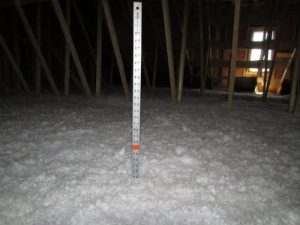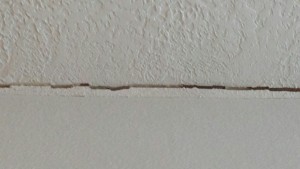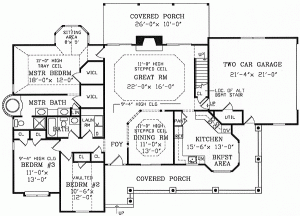I so enjoy clients who truly care about the outcomes of their post frame buildings. In this case, I’ve been back and forth with reader Eric and today we are discussing how insulation in walls works.
Eric writes:
“Mike,
 Thanks again for the input. I read those articles you mentioned on the BIBs and the white liner panels. The liner panels are very common and popular around here but the article had very good points and gave me more to think about. As for the insulation, I was not familiar with the BIBs system and was impressed. I have done some more reading and reached out to a few contractors for quotes on the BIBs system. I do prefer to do things myself whenever possible however, so the option of installing fiberglass myself is still on the table. This is where I still have a question. You mentioned to fill the entire wall cavity with unfaced fiberglass and then cover with Visqueen. Is there an issue if the cavity is not completely filled and an air space is created between the fiberglass and the Tyvek® behind the metal sheeting? I ask because my walls are roughly 5 1/2” deep and obviously R13 is only 3 1/2” thick and R19 is 6 1/2” thick. If I go with R13 (cheaper) I end up with an air space. If I go with R19, I end up compressing it and losing r value anyway. Also, I have diagonal bracing in the corners which will also make it near impossible to tightly fill with fiberglass batts. I would love to go with the BIBs system but am waiting to see if it is within budget. If I can save considerable money insulating myself with batts I would most likely do so but need to be sure I am not causing problems down the road. Sorry for being so long winded and thank you very much for all your help and information.”
Thanks again for the input. I read those articles you mentioned on the BIBs and the white liner panels. The liner panels are very common and popular around here but the article had very good points and gave me more to think about. As for the insulation, I was not familiar with the BIBs system and was impressed. I have done some more reading and reached out to a few contractors for quotes on the BIBs system. I do prefer to do things myself whenever possible however, so the option of installing fiberglass myself is still on the table. This is where I still have a question. You mentioned to fill the entire wall cavity with unfaced fiberglass and then cover with Visqueen. Is there an issue if the cavity is not completely filled and an air space is created between the fiberglass and the Tyvek® behind the metal sheeting? I ask because my walls are roughly 5 1/2” deep and obviously R13 is only 3 1/2” thick and R19 is 6 1/2” thick. If I go with R13 (cheaper) I end up with an air space. If I go with R19, I end up compressing it and losing r value anyway. Also, I have diagonal bracing in the corners which will also make it near impossible to tightly fill with fiberglass batts. I would love to go with the BIBs system but am waiting to see if it is within budget. If I can save considerable money insulating myself with batts I would most likely do so but need to be sure I am not causing problems down the road. Sorry for being so long winded and thank you very much for all your help and information.”
Mike the Pole Barn Guru responds: How Insulation Works
Fiberglass itself has little resistance to heat flow. The actual insulator is the air trapped in the tiny spaces between glass fibers. The tiny air voids slow conductive heat movement, while the glass fibers reduce radiant losses and impede air movement to block convective heat flow.
Don’t be fooled by so-called dead air spaces. Small air voids slow heat flow, but large voids don’t. A dead air space is one in which air does not move — once a gap gets larger than 3/4 inch, convection kicks in and overrides the insulating effect. Even though they contain air, uninsulated framing cavities have little or no R-value.
Making contact.
This understanding should govern the way batts are installed in the field. They should make good contact with wall and ceiling and nestle snugly against the sub-floor at the base within wall cavities. If the batts don’t touch the inside face of the drywall and the housewrap, convection coupled with air leakage will seriously undermine their thermal performance. Use only unfaced batts in exterior walls, because we’ve found inset stapled kraft-faced batts tend to create gaps between the insulation and the drywall. (Using unfaced batts also prevents the drywallers from complaining about the presence of stapling flanges on the surface of the framing.)
In other words, even though shoving batts into a wall girt cavity may seem like a no-brainer, doing it right takes some care. If a batt is simply jammed into place, its edges tend to drag along the sides of the girts on either side, which often prevents the rear corners of the batt from coming into contact with the exterior sheathing.
Moral of the Story
If your budget does not include closed cell spray foam insulation, then BIBs is a great solution and is effective.









This BIBs system system sounds interesting but very labor intensive.
Do you know how it compares cost wise to other alternatives?
And, if it starts with blown poly, why not just fill the cavity with poly?
And if it finishes with blown glass, why not blown glass in the whole cavity?
What are the advantages of mixing technologies?
Dan
BIBs has to be done by a licensed installer. I’ve used it in two of my own buildings and been very satisfied with the results and found the cost to be very comparable with installed fiberglass batts (and far more energy efficient).
Closed cell spray foam is fairly expensive, however it is a very efficient condensation control as well as it insures any voids or possible air leaks are eliminated.
In the end, the determination of what works best for you is going to ride upon your budget. For a highly climate controlled space, the extra investment in thicker closed cell spray foam might pay off over time. The advantages of mixing? Pocket book.
Thanks,
Just wondered as glass batts are dirt cheap and old school, my kid did the spray poly himself for a few $100.
I suppose if the job is being contracted and you’re buying labor, then the BIDs becomes cost effective.
Dan
Fiberglass batts are just not very efficient and are difficult to properly install.
Home Depot has Green Fiber, Low Dust Cellulose blow in insulation available (at least in my area) with free 24 hour machine rental with the purchase of 20 bags of product. Use of a Mooney wall (Google is your friend) would reduce thermal bridging and the Insul Mesh stops the cellulose going everywhere. I realize the HD DIY approach may not be quite as effective as BIBs but it is an option. I used to be a fan of spray in foam but after reviewing numerous accounts of improperly applied product that led to the off gassing of dangerous chemicals in homes, often to the point of making the inhabitants sick, foam will never be a part of an insulation plan for my family. Thanks for the blogs, great info!
With post frame construction the Mooney Wall concept (https://www.builditsolar.com/Projects/Conservation/MooneyWall/MooneyWall.htm for those who don’t want to Google) can be taken one step further. By having an independent set of girts on the inside of the wall columns, the only thermal bridging is through the columns. When I met my lovely now bride, she loved in a double wide manufactured home. We used the same product from The Home Depot in all of the interior walls to reduce sound transmission, so I am very familiar with it. I was never a fan of spray foam until after our oldest son Jake used it in the addition to his home. When we added the elevator shaft to the back of the house last year, we used closed cell spray foam in it – my only regret being I listened to the installer and didn’t go as thick as I felt we should have.
Appreciate the nice comment, hope I am keeping you both informed and entertained.